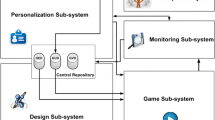Abstract
In networked game development, there are issues related to the technology and tuning required to implement communication features, such as synchronization control between terminals, suitable display updates, and adjustment of communication frequencies. This knowledge of development requires a lot of learning time to acquire in practice because the operations of communication are not transparent, and this may be a factor that prevents newcomers from entering the market. Therefore, the authors propose a networked game development learning support tool for beginner networked game developers without the above-mentioned development skills. Concretely, the authors propose an object allocation system that supports networked game development by providing users with intuitive operation and a visual understanding of networked game development skills. Subject experiment and learning task to evaluate learning effectiveness using the proposed system has been planned.
Access this chapter
Tax calculation will be finalised at checkout
Purchases are for personal use only
Similar content being viewed by others
References
Baldonado, M., Chang, C.-C.K., Gravano, L., Paepcke, A.: The stanford digital library metadata architecture. Int. J. Digit. Libr. 1, 108–121 (1997)
Bruce, K.B., Cardelli, L., Pierce, B.C.: Comparing object encodings. In: Abadi, M., Ito, T. (eds.) Theoretical Aspects of Computer Software. Lecture Notes in Computer Science, vol. 1281, pp. 415–438. Springer-Verlag, Berlin Heidelberg New York (1997)
van Leeuwen, J. (ed.): Computer Science Today. Recent Trends and Developments. Lecture Notes in Computer Science, vol. 1000. Springer-Verlag, Berlin Heidelberg New York (1995)
Michalewicz, Z.: Genetic Algorithms + Data Structures = Evolution Programs, 3rd edn. Springer-Verlag, Berlin Heidelberg New York (1996)
Miyuki, M., Naoko, K., Tetsuro, K.: A Practical Report on Self-Learning and Analysis of Student Activity Utilizing Programming Education Support Tool pgtracer. IPSJ Transactions on Computers and Education (June 2020). (in Japanese)
Tetsuro, K., Ryo, Y., Kosuke, O.: Development and Evaluation of Programming Education Support Tool pgtracer Utilizing Fill-in-the-Blank Question. IPSJ Transactions on Computers and Education (Oct 2016). (in Japanese)
Homepage of Team Kamada: What is Islay ?, http://puma.cis.ibaraki.ac.jp/research/islay.html. Accessed 25 May 2022 (in Japanese)
Mizuaki, Y., Tatsuhiro, Y., Shusuke, O., Masaru, K., Toshiro, A.: A Proposal of Visual Web Browser Programming Based on State Transition Diagram. IEICE TRANSACTIONS on Information and Systems (Oct 2006). (in Japanese)
Scratch Foundation: About Scratch. https://scratch.mit.edu/about. Accessed 25 May 2022 (in Japanese)
Author information
Authors and Affiliations
Corresponding author
Editor information
Editors and Affiliations
Rights and permissions
Copyright information
© 2022 The Author(s), under exclusive license to Springer Nature Switzerland AG
About this paper
Cite this paper
Osuga, Y., Kawano, Y., Murakami, Y., Hanawa, D., Hanada, M., Nunohiro, E. (2022). Web Game Development Tool for Learning Communication Functions for Beginners Networked Game Developers. In: Barolli, L., Miwa, H., Enokido, T. (eds) Advances in Network-Based Information Systems. NBiS 2022. Lecture Notes in Networks and Systems, vol 526. Springer, Cham. https://doi.org/10.1007/978-3-031-14314-4_51
Download citation
DOI: https://doi.org/10.1007/978-3-031-14314-4_51
Published:
Publisher Name: Springer, Cham
Print ISBN: 978-3-031-14313-7
Online ISBN: 978-3-031-14314-4
eBook Packages: Intelligent Technologies and RoboticsIntelligent Technologies and Robotics (R0)




